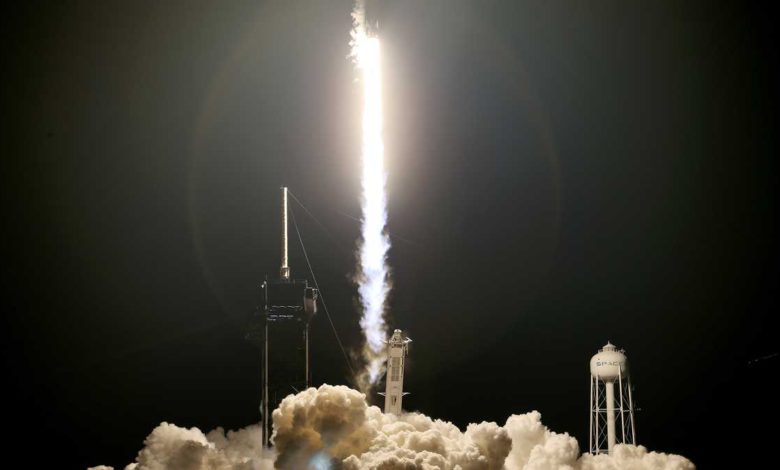

As Jared Isaacman and his three fellow crewmates were free-flying through Earth's orbit, shielded from the unforgiving vacuum of space by nothing but a 13-foot-wide carbon-fiber capsule, an alarm started blaring.The SpaceX Crew Dragon spacecraft's systems were warning the crew of a "significant" issue, Isaacman said. They'd spent months poring over SpaceX manuals and training to respond to in-space emergencies, so they leaped into action, working with SpaceX ground controllers to pinpoint the cause of the error.As it turned out, the Crew Dragon wasn't in jeopardy. But the on-board toilet was.Nothing in space is easy, including going to the bathroom. In a healthy human on Earth, making sure everything ends up in the toilet is usually a matter of simple aim. But in space, there is no feeling of gravity. There's no guarantee that what comes out will go where it's supposed to. Waste can — and does — go in every possible direction.To solve that problem, space toilets have fans inside them, which are used to create suction. Essentially they pull waste out of the human body and keep it stored away.And the Crew Dragon's "waste management system" fans were experiencing mechanical problems. That is what tripped the alarm the crew heard.Scott "Kidd" Poteet, an Inspiration4 mission director who helped oversee the mission from the ground, tipped reporters off about the issue in an interview with CBS. Poteet and SpaceX's director of crew mission management later confirmed there were "issues" with the waste management system at a press conference but didn't go into detail, setting off an immediate wave of speculation that the error could've created a disastrous mess.When asked directly about that on Thursday, however, Isaacman said "I want to be 100% clear: There were no issues in the cabin at all as it relates to that."But Isaacman and his fellow travelers on the Inspiration4 mission did have to work with SpaceX to respond to the problem during their three-day stay in orbit, during which they experienced numerous communications blackouts, highlighting the importance of the crew's thorough training regimen."I would say probably somewhere around 10% of our time on orbit we had no , and we were a very calm, cool crew during that," he said, adding that "mental toughness and a good frame of mind and a good attitude" were crucial to the mission."The psychological aspect is one area where you can't compromise because...there were obviously circumstances that happened up there where if you had somebody that didn't have that mental toughness and started to react poorly, that really could've brought down the whole mission," Isaacman said.SpaceX did not respond to CNN's requests for comment.The toilet anecdote also highlights a fundamental truth about humanity and its extraterrestrial ambitions — no matter how polished and glitzy we may imagine our space-faring future, biological realities remain.Excreta in space, a historyIsaacman was — as numerous astronauts before him — bashful when it came to discussing the "toilet situation.""Nobody really wants to get into the gory details," Isaacman said. But when the Inspiration4 crew talked to some NASA astronauts, they said "using the bathroom in space is hard, and you've got to be very — what was the word? — very kind to one another."He added that, despite the on-board toilet issues, nobody suffered any accidents or indignities."I don't know who was training them, but we were able to work through it and get going even with what was initially challenging circumstances, so there was nothing ever like, you know, in the cabin or anything like that," he said.Figuring out how to safely relieve oneself in space was, however, was a fundamental question posed at the dawn of human spaceflight half a century ago, and the path to answers was not error-free.During the 1969 Apollo 10 mission — the one that saw Thomas Stafford, John Young and Eugene Cernan circumnavigate the moon — Stafford reported back to mission control on Day Six of the mission that a piece of waste was floating through the cabin, according to once-confidential government documents."Give me a napkin, quick," Stafford is recorded as saying a few minutes before Cernan spots another one: "Here's another goddamn turd."The feces collection process at the time, a NASA report later revealed, was an "extremely basic" plastic bag that was "taped to the buttocks.""The fecal bag system was marginally functional and was described as very 'distasteful' by the crew," an official NASA report from 2007 later revealed. "The bags provided no odor control in the small capsule and the odor was prominent."In-space toilets have evolved since then, thanks to strenuous efforts from NASA scientists, as journalist Mary Roach, author of "Packing for Mars," told NPR in 2010."The problem here is you've got this very elaborate space toilet, and you need to test it. Well, you've got to, you know, haul it over to Ellington Field, board it onto a zero-gravity simulator — a plane that does these elaborate up-and-down arcs — and then you've got to find some poor volunteer from the Waste System Management Office to test it. And I don't know about you, but, I mean, to do it on demand in 20 seconds, now that is asking a lot of your colon. So it's very elaborate and tricky."And, Roach writes in "Packing for Mars," astronaut potty training is no laughing matter."The simple act of urination can, without gravity, become a medical emergency requiring catheterization and embarrassing radio consults with flight surgeons," she wrote. And because urine behaves differently inside the bladder in space, it can be very difficult to tell when one needs to go.
As Jared Isaacman and his three fellow crewmates were free-flying through Earth's orbit, shielded from the unforgiving vacuum of space by nothing but a 13-foot-wide carbon-fiber capsule, an alarm started blaring.
The SpaceX Crew Dragon spacecraft's systems were warning the crew of a "significant" issue, Isaacman said. They'd spent months poring over SpaceX manuals and training to respond to in-space emergencies, so they leaped into action, working with SpaceX ground controllers to pinpoint the cause of the error.
As it turned out, the Crew Dragon wasn't in jeopardy. But the on-board toilet was.
Nothing in space is easy, including going to the bathroom. In a healthy human on Earth, making sure everything ends up in the toilet is usually a matter of simple aim. But in space, there is no feeling of gravity. There's no guarantee that what comes out will go where it's supposed to. Waste can — and does — go in every possible direction.
To solve that problem, space toilets have fans inside them, which are used to create suction. Essentially they pull waste out of the human body and keep it stored away.
And the Crew Dragon's "waste management system" fans were experiencing mechanical problems. That is what tripped the alarm the crew heard.
Scott "Kidd" Poteet, an Inspiration4 mission director who helped oversee the mission from the ground, tipped reporters off about the issue in an interview with CBS. Poteet and SpaceX's director of crew mission management later confirmed there were "issues" with the waste management system at a press conference but didn't go into detail, setting off an immediate wave of speculation that the error could've created a disastrous mess.
When asked directly about that on Thursday, however, Isaacman said "I want to be 100% clear: There were no issues in the cabin at all as it relates to that."
But Isaacman and his fellow travelers on the Inspiration4 mission did have to work with SpaceX to respond to the problem during their three-day stay in orbit, during which they experienced numerous communications blackouts, highlighting the importance of the crew's thorough training regimen.
"I would say probably somewhere around 10% of our time on orbit we had no [communication with the ground], and we were a very calm, cool crew during that," he said, adding that "mental toughness and a good frame of mind and a good attitude" were crucial to the mission.
"The psychological aspect is one area where you can't compromise because...there were obviously circumstances that happened up there where if you had somebody that didn't have that mental toughness and started to react poorly, that really could've brought down the whole mission," Isaacman said.
SpaceX did not respond to CNN's requests for comment.
The toilet anecdote also highlights a fundamental truth about humanity and its extraterrestrial ambitions — no matter how polished and glitzy we may imagine our space-faring future, biological realities remain.
Excreta in space, a history
Isaacman was — as numerous astronauts before him — bashful when it came to discussing the "toilet situation."
"Nobody really wants to get into the gory details," Isaacman said. But when the Inspiration4 crew talked to some NASA astronauts, they said "using the bathroom in space is hard, and you've got to be very — what was the word? — very kind to one another."
He added that, despite the on-board toilet issues, nobody suffered any accidents or indignities.
"I don't know who was training them, but we were able to work through it and get [the toilet] going even with what was initially challenging circumstances, so there was nothing ever like, you know, in the cabin or anything like that," he said.
Figuring out how to safely relieve oneself in space was, however, was a fundamental question posed at the dawn of human spaceflight half a century ago, and the path to answers was not error-free.
During the 1969 Apollo 10 mission — the one that saw Thomas Stafford, John Young and Eugene Cernan circumnavigate the moon — Stafford reported back to mission control on Day Six of the mission that a piece of waste was floating through the cabin, according to once-confidential government documents.
"Give me a napkin, quick," Stafford is recorded as saying a few minutes before Cernan spots another one: "Here's another goddamn turd."
The feces collection process at the time, a NASA report later revealed, was an "extremely basic" plastic bag that was "taped to the buttocks."
"The fecal bag system was marginally functional and was described as very 'distasteful' by the crew," an official NASA report from 2007 later revealed. "The bags provided no odor control in the small capsule and the odor was prominent."
In-space toilets have evolved since then, thanks to strenuous efforts from NASA scientists, as journalist Mary Roach, author of "Packing for Mars," told NPR in 2010.
"The problem here is you've got this very elaborate space toilet, and you need to test it. Well, you've got to, you know, haul it over to Ellington Field, board it onto a zero-gravity simulator — a plane that does these elaborate up-and-down arcs — and then you've got to find some poor volunteer from the Waste System Management Office to test it. And I don't know about you, but, I mean, to do it on demand in 20 seconds, now that is asking a lot of your colon. So it's very elaborate and tricky."
And, Roach writes in "Packing for Mars," astronaut potty training is no laughing matter.
"The simple act of urination can, without gravity, become a medical emergency requiring catheterization and embarrassing radio consults with flight surgeons," she wrote. And because urine behaves differently inside the bladder in space, it can be very difficult to tell when one needs to go.
Source link








